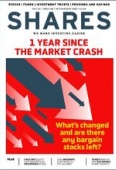Archived article
Please note that tax, investment, pension and ISA rules can change and the information and any views contained in this article may now be inaccurate.
Global stocks see largest ever week of buying

The opening week of February saw the largest ever weekly inflow of cash into global shares, according to Bank of America’s global research team, as well as the largest ever inflow into technology stocks.
Of the total inflow of $58.1 billion into equities, some $25.1 billion or close to half flowed into US large-cap stocks, the second-highest figure on record, while $5.6 billion flowed into US small-cap stocks, the third highest figure on record.
Technology stocks posted their best ever week of inflows at $5.4 billion, while flows into bonds reached $13.1bn, pushing the yield on US ‘junk’ or sub-investment grade loans to below 4% for the first time in history, despite a 33% increase in issuance compared with 2020.
Part of these inflows were financed by investors taking $10.6 billion out of their cash holdings, with Bank of America noting it saw the biggest drawdown of cash by its own private clients since September 2019.
Investors also withdrew $800 million from gold funds, marking the first month of net outflows in two months.
Private client asset allocation at the bank marked a new high for equities at 63.1%, while bonds made up 19.1% and cash was reduced to 11.7%.

Analysts warned that as more people are vaccinated and the US reopens, the ‘velocity’ of money through the economy will lead to a spike in inflation as consumers go on a spending spree.
At the same time, companies are likely to use the reopening to lift prices, as seen in the latest small business survey which showed plans to raise prices in the next three months were at the highest level in two years.
In that scenario, analysts believe, real assets such as commodities, real estate and ‘collectibles’ including art, fine wine and luxury goods are likely to outperform financial assets like stocks and bonds, which have a poor track record during periods of sharply rising inflation and interest rates.
At the same time, the bank flagged that its Bull & Bear equity market indicator had moved another notch towards ‘Sell’ territory, from 7.5 to 7.7, with a reminder that the last time the indicator gave a ‘contrarian’ Sell signal was 30 January 2018.
The median three-month return from a ‘Sell’ signal, of which there have been 12 since 2000, is minus 9% for global stocks and minus 45 basis points or 0.45% for the US 10-year Treasury yield, as investors dump stocks for the safety of US government bonds (bond yields fall as prices rise).

Important information:
These articles are provided by Shares magazine which is published by AJ Bell Media, a part of AJ Bell. Shares is not written by AJ Bell.
Shares is provided for your general information and use and is not a personal recommendation to invest. It is not intended to be relied upon by you in making or not making any investment decisions. The investments referred to in these articles will not be suitable for all investors. If in doubt please seek appropriate independent financial advice.
Investors acting on the information in these articles do so at their own risk and AJ Bell Media and its staff do not accept liability for losses suffered by investors as a result of their investment decisions.

 magazine
magazine








